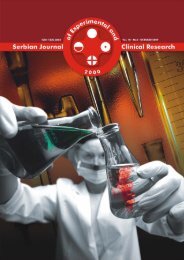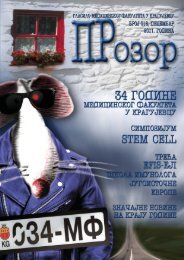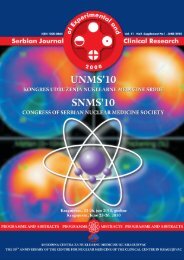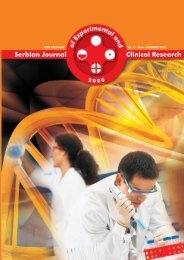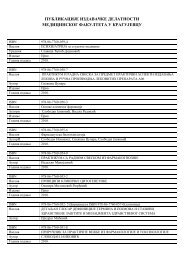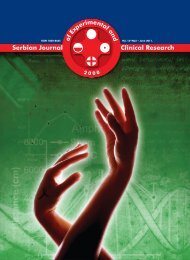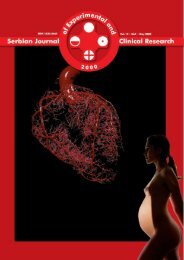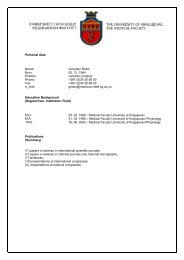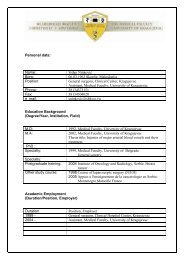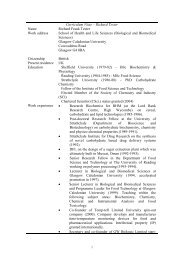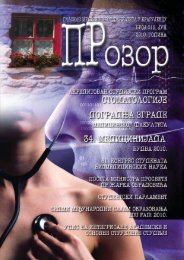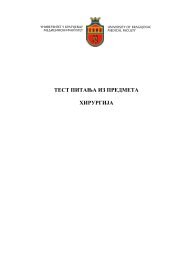neurotoxicity and mechanisms of induced hyperexcitability
neurotoxicity and mechanisms of induced hyperexcitability
neurotoxicity and mechanisms of induced hyperexcitability
Create successful ePaper yourself
Turn your PDF publications into a flip-book with our unique Google optimized e-Paper software.
EXPERIMENTALMass spectrometry (MS)Dextromethorphan drug (DMP)Figure 1. Structure <strong>and</strong> numbering system <strong>of</strong> DMP for, C, N <strong>and</strong> O skelton.may be deduced, thus greatly facilitating the interpretation <strong>of</strong>thermal degradation processes. In contrast, the computationalquantum chemistry could provide additional informationabout the atoms <strong>and</strong> bonds, which could be used successfullyin an interpretation <strong>of</strong> experimental results [23]. The application<strong>of</strong> the computational quantum chemistry in addition toexperimental results (MS <strong>and</strong> TA) gives valuable informationabout the atoms <strong>and</strong> bonds, which helps in the description<strong>and</strong> prediction <strong>of</strong> the primary fragmentation site <strong>of</strong> cleavage<strong>and</strong> subsequent ones [24-28].Although the literature is wealthy in information relatedto the biological activities <strong>of</strong> DMP <strong>and</strong> its metabolites in vivo<strong>and</strong> in vitro [3-6], there seems to be a lack <strong>of</strong> any correlationbetween chemical behaviour <strong>and</strong> its electronic structure.The main aim <strong>of</strong> this work was to perform an experimental<strong>and</strong> theoretical investigation <strong>of</strong> DM using thermalanalyses (TA) <strong>and</strong> EI mass spectral (MS) fragmentation at70 eV. In addition, MO calculations were performed usingthe PM3 procedure on the neutral molecule <strong>and</strong> chargedmolecule to investigate geometrical parameters (bondlength, bond order, bond strain, heats <strong>of</strong> formation ionisationenergy) <strong>and</strong> charge distribution.The calculations correlated the experimental results[TA <strong>and</strong> MS] to obtained information regarding the stability<strong>of</strong> the drug <strong>and</strong> the prediction <strong>of</strong> the site <strong>of</strong> primaryfragmentation <strong>and</strong> subsequent ones. This study could behelpful in establishing a quantitative <strong>and</strong> qualitative structure–activityrelationship for the drug, which is the mainobjective <strong>of</strong> this work. It is worth mentioning that there isscant literature concerning such a comparative study.Moreover, the authors tried to correlate <strong>and</strong> discuss thestructure reactivity <strong>and</strong> relationship between DM <strong>and</strong> Codeine[26], which are chemically related to each other [2]<strong>and</strong> which affect the O <strong>and</strong> OH on MS <strong>and</strong> TA <strong>and</strong> MOparameters. In addition, they attempted to find the metabolitestructures in the mass spectrum <strong>and</strong> correlated thebiological behaviour <strong>of</strong> the two drugs.The electron ionisation (EI) mass spectrum <strong>of</strong> DMPwas obtained using a Shimadzu GC-MS-Qp 1000 PX quadruplemass spectrometer with an electron multiplier detectorequipped with the GC-MS data system. The directprobe for solid material was used in this study. The samplewas put into a glass sample micro vial by a needle (˜ 1 μgmax). The vial was installed on the tip <strong>of</strong> the DP containingthe heating cable <strong>and</strong> was inserted into the evacuatedion source. The sample was ionised by an electron beamemitted from the filament with the generated ions beingeffectively introduced into the analyser by the focusing <strong>and</strong>extractor lens systems. The MS was continuously scanned,<strong>and</strong> the spectra obtained were stored. The electron ionisationmass spectra were obtained at an ionising energyvalue <strong>of</strong> 70 eV, ionisation current <strong>of</strong> 60 μA <strong>and</strong> a vacuumgreater than 10 -6 tor r.Thermal analysis (TA)The thermal analyses <strong>of</strong> DMP were made using a conventionalthermal analyser (Shimadzu system <strong>of</strong> DTA-50<strong>and</strong> 30 series TG-50). The mass loss for 5 mg <strong>of</strong> sample <strong>and</strong>the heat response to changes in the sample were measuredfrom room temperature up to 600ºC. The heating rate in aninert argon atmosphere was 10ºC min -1 . These instrumentswere calibrated using indium metal as a thermal stable material.The reproducibility <strong>of</strong> the instrument reading was determinedby repeating each experiment more than twice.Quantum chemical calculationsThe MO calculations were performed using a semiempiricalmolecular orbital calculation. The method usedin these computations was the parametric PM-3 methoddescribed by Stewart [29]. The geometry <strong>of</strong> all stable speciesstudied was completely optimised with respect to allgeometrical variables using the Eigen vector following (EF)routine [30]. The program was run under the molecularorbital calculation package MOPAC2000 by Stewart [31]for microcomputers.RESULTS AND DISCUSSIONThe chemistry <strong>and</strong> reactivity <strong>of</strong> pharmaceutical drugsare <strong>of</strong> great interest because <strong>of</strong> their importance in treatingvarious diseases. Knowledge <strong>of</strong> the thermal decompositionmechanism <strong>of</strong> the drug is very important to underst<strong>and</strong>the chemical processes in biological systems. It is difficultto establish the exact major fragmentation pathway in EIusing conventional MS. However, the combination <strong>of</strong> experimentaltechniques (TA <strong>and</strong> MS) <strong>and</strong> MO calculation isvery important to underst<strong>and</strong> the following topics:22



